
Cutthroat. Ruthless. Dog-eat-dog.
No, I’m not introducing this year’s hottest action movie – I’m talking about the world of business.
Nowadays, it’s quicker and easier than ever to get a business up and running. Hell, with the emergence of low code and no-code platforms, it’s not just quick and easy but downright simple.
But only 3 out of 4 companies featured in the S&P 500 list will still be relevant – and even exist – in 2027.
With this stark realization, how do startup hopefuls and the Fortune 500 alike know if they’ve got the resources and capabilities to not only stay in the game for the long-haul, but have an overall competitive advantage?
VRIO.
I last discussed VRIO in my post What is VRIO? The 4-Step Framework for Continuous Business Success, where I laid the foundation for understanding what VRIO is, where it came from, and how to navigate the framework.
However, in this post, I’ll be taking things one step further.
I’ll recap what VRIO is (handy for those who don’t already know!), discuss the specific benefits of VRIO analysis, and even provide you with a free VRIO analysis checklist – made by us here at Process Street!
Just read through the following sections to get started:
- What is the VRIO definition?
- The benefits of using the VRIO model for business analysis
- Using Process Street’s VRIO analysis checklist
- Tips for undergoing VRIO analysis with our checklist
- Additional resources for a sustained competitive advantage
The clock’s ticking, so let’s jump in! ⏱
What is the VRIO definition?
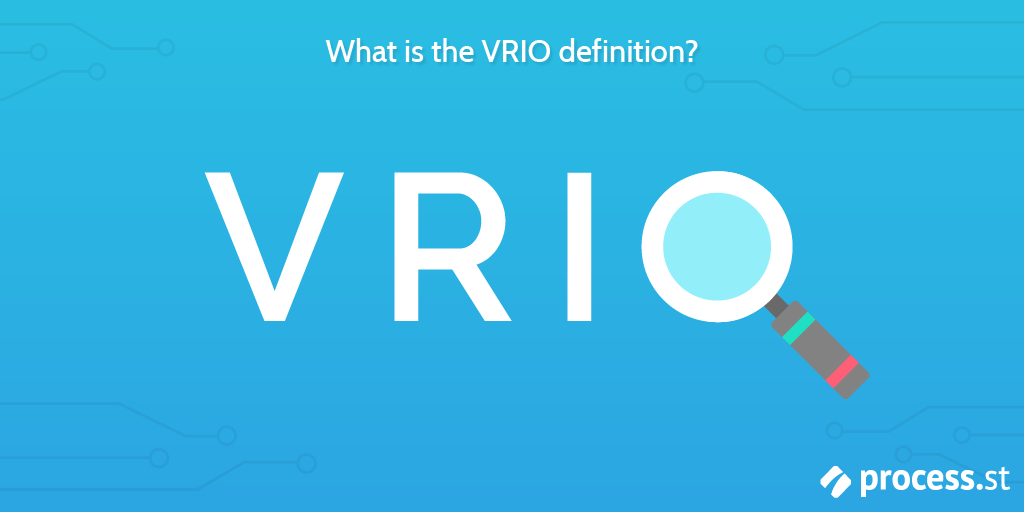
VRIO is a four-part business analysis framework used to determine a business’ competitive potential.
The analysis process takes a resource or capability through four different dimensions (value, rarity, imitability, and organization). These dimensions assess whether the resource or capability in question is unique, easily replicable, or if there’s enough organization in place to capture value.
Once the analysis has been completed, the resource/capability will be determined as having either a:
- Competitive disadvantage.
- Competitive parity.
- Temporary competitive advantage.
- Unused competitive advantage.
- Sustained competitive advantage.
What does each of these results mean for your business, exactly?
Let me explain.
VRIO analysis outcome #1: Competitive disadvantage
Starting off, if a resource/capability is established as being not valuable to customers and consumers, there’s a competitive disadvantage.
This shouldn’t be a shock to anyone: If the business is doing or utilizing something that’s not valuable for their customer base, that’s nothing but a drain on money, effort, and time!
VRIO analysis outcome #2: Competitive parity
If a resource/capability has value but isn’t in demand or is easy to come by, it fails the rarity dimension and is said to bring competitive parity.
Competitive parity, essentially, means being on equal footing with your competitors in a certain area.
Should a resource/capability be determined as both valuable and rare, it moves onto the next step where its imitability is judged.
VRIO analysis outcome #3: Temporary competitive advantage
If the end-result of the analysis is that the resource/capability is easily replicable, there’s a temporary competitive advantage.
Although this is one of the more positive results, it’s key the organization in question does what they can with the resource/capability to remain ahead of the curve (easier said than done!)
VRIO analysis outcome #4: Unused competitive advantage
What’s better than a temporary competitive advantage is an unused competitive advantage, as this means the resource/capability is valuable, rare, and inimitable.
There’s an “unused” advantage, though, because the right systems, processes, and procedures aren’t in place for the organization to truly capture value.
VRIO analysis outcome #5: Sustained competitive advantage
A sustained competitive advantage, then, is the best possible outcome.
It means that the resource/capability is bringing multifaceted advantages to your business, and systems, processes, and procedures are in place to help it succeed!
With those important concepts and definitions covered, it’s time to look at the specific benefits of VRIO analysis. ⬇️
The benefits of using the VRIO model for business analysis
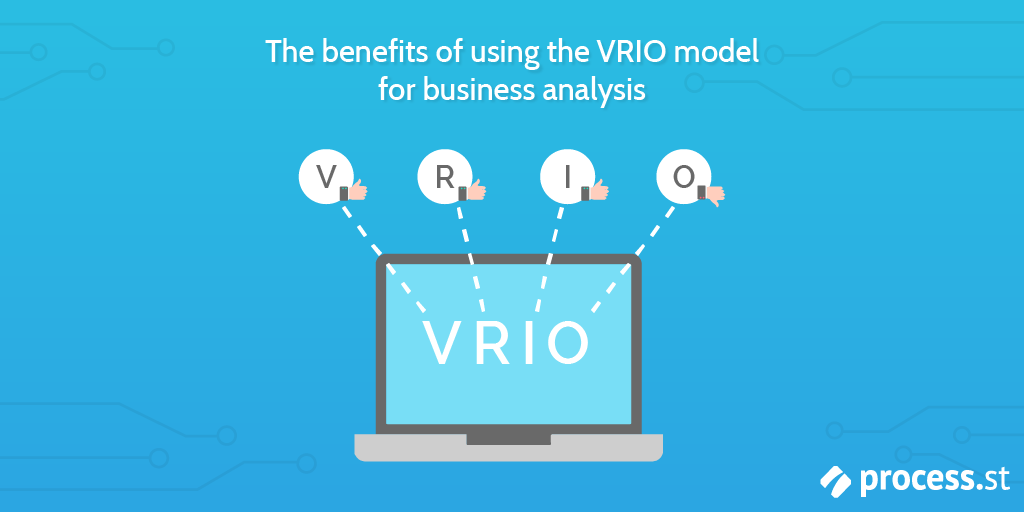
I wouldn’t be writing this article if VRIO analysis didn’t bring about some pretty nifty benefits for businesses. And especially when there are a plethora of other business analysis tools that could be taken advantage of, like gap analysis and Six Sigma.
In fact, the reason why I’ve written about VRIO twice now is that it’s just so valuable.
Why?
Because, as Rameez M Sydeek at Feedough says:
“The advantage of a VRIO analysis is its simplicity and clarity. Almost every firm uses VRIO analysis in combination with other analytical techniques to help evaluate business resources and capabilities in a more detailed view.” – Rameez M Sydeek, VRIO Framework Explained
But there are more benefits than its simplicity and clarity:
-
- VRIO analysis reveals where your business is succeeding – and where it’s failing, too.
The whole point of VRIO analysis is that it helps you to uncover the pain-points in your business, showing you the resources/capabilities that are stopping you from getting ahead of competitors. Not only this, but it also reaffirms the resources/capabilities that are working effectively, ensuring you don’t cancel or stop the usage of resources/capabilities that have positive impacts.
-
- The VRIO framework is broad – any resource/capability can be analyzed.
What’s great about VRIO analysis is that the framework it uses is broad. Specifically, this means any resource or capability can be put through VRIO analysis. For instance, if I was a solopreneur that developed a SaaS product for the medical field, I could run the resources behind the business software through VRIO, in addition to the capabilities I had at hand to make the product as successful as possible.
Ergo: With VRIO, there’s no limit to what can be analyzed.
-
- Despite the framework being broad, VRIO analysis can be done extremely quickly. ⏱
VRIO is, indeed, broad – and that’s a great thing. But that doesn’t mean that it takes a decade to analyze a resource/capability. Rather, it takes mere minutes to test a resource or capability’s mettle. This should be music to the ears of time-strapped readers who’ve been uncertain about undergoing VRIO, but weren’t sure how long it would take. It’s incredibly fast.
-
- It’s a highly-repeatable process.
Because it takes so little time to analyze a resource or capability, it’s completely possible to analyze a whole bunch of them back-to-back. Let’s say a multinational corporation had 20 resources and capabilities they wanted to analyze; they’d be able to blast through that stack of 20 quickly. As I said in the above section, it’s only a matter of minutes for a resource/capability to be tested (as long as you have the right tools for undergoing VRIO analysis!)
-
- It can be used to analyze competitors. ️♂️
Whoever came up with the quote “All is fair in love and war” forgot to mention that the rule also extends to business. And as part of a business, you want yours to reign supreme – or at least, as close to the top as it can possibly get!
So, as well as analyzing your own business’ resources and capabilities, you can also analyze your competitors’. In U.S. Coffee and Snack Shop Industry: A Comparative Analysis of Starbucks and Dunkin’ Donuts – a study by Jennifer Azarian et al – they compared the VRIO results of Starbucks and Dunkin’ Donuts, despite any of the people being affiliated with either company in any way, shape, or form.
Want to investigate and compare your business advantages versus your competitors’? Try VRIO analysis.
Impressive list, right?
If now’s the point where you’re asking yourself “What tools do I need to get analyzing with VRIO?” after reading those pretty stellar positives, then do I have a present for you, reader.
In fact, all your birthdays have come at once.
Pop open the champagne and the confetti poppers alike (preferably away from your offices’ computers), because we’ve built a free, super useful – and not to mention dynamic – VRIO analysis checklist for you!
Using Process Street’s VRIO analysis checklist
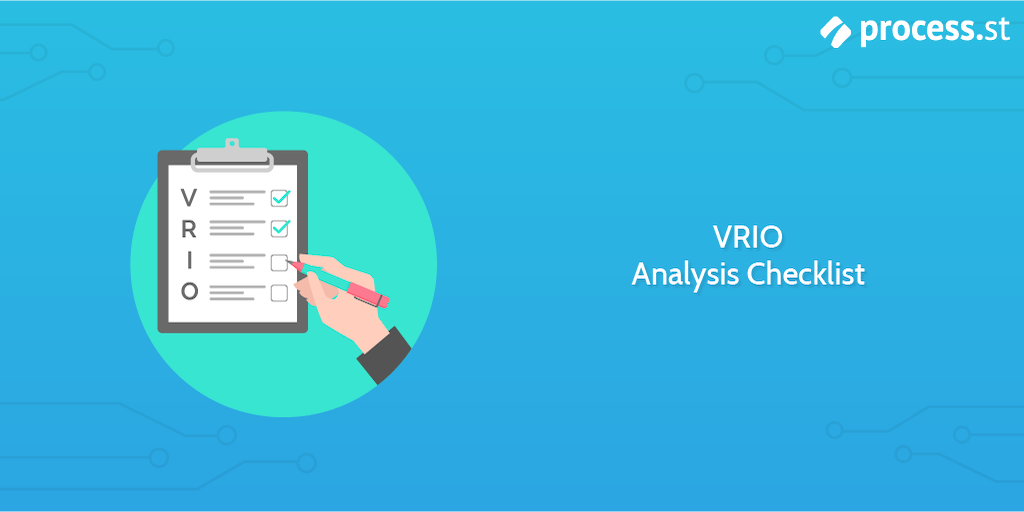
Before jumping into and fully exploring the VRIO analysis checklist, let me describe Process Street in a little more detail.
Process Street is superpowered checklists.
For those checklists to be made, important business processes, workflows, and procedures must be documented as templates.
Once the templates have been made, an infinite number of checklists can be launched from those templates, meaning you can complete your recurring tasks and processes again and again all to a high standard – and while keeping human error at bay, too!
Check out the short, introductory video below for a glimpse into Process Street’s state-of-the-art checklist app.
Now, what makes our checklists superpowered is our incredible workflow features.
One of these workflow features in particular – conditional logic, which enables checklists to dynamically change when certain things happen (or don’t) – has been baked into the VRIO analysis checklist that’s embedded below.
To illustrate how conditional logic works with this checklist, let’s look at a use case where you’re the star.
Process Street’s VRIO analysis checklist: A VRIO analysis example
You’re a part of senior management. (If you weren’t before, you are now – suspend your disbelief for a minute or two!)
Your focus is on your company’s’ internal workings, ensuring that everything’s in place so your employees can get good work done – all the time. To double-check your resources and capabilities are as good as you think they are, you want to undertake VRIO analysis for the first time.
After signing up for a free trial and adding the VRIO analysis checklist to your dashboard, you launch the checklist for the first capability you want to test.
The first doable task in the checklist – “Define the resource/capability” – asks you to input the details of the resource/capability at hand.
This is so if you’ve got a stack of 20 resources/capabilities you want to go through, you can go back and remind yourself of what’s being analyzed, should you forget. Plus, it’s handy should you want to come back to an archived checklist at a later date!
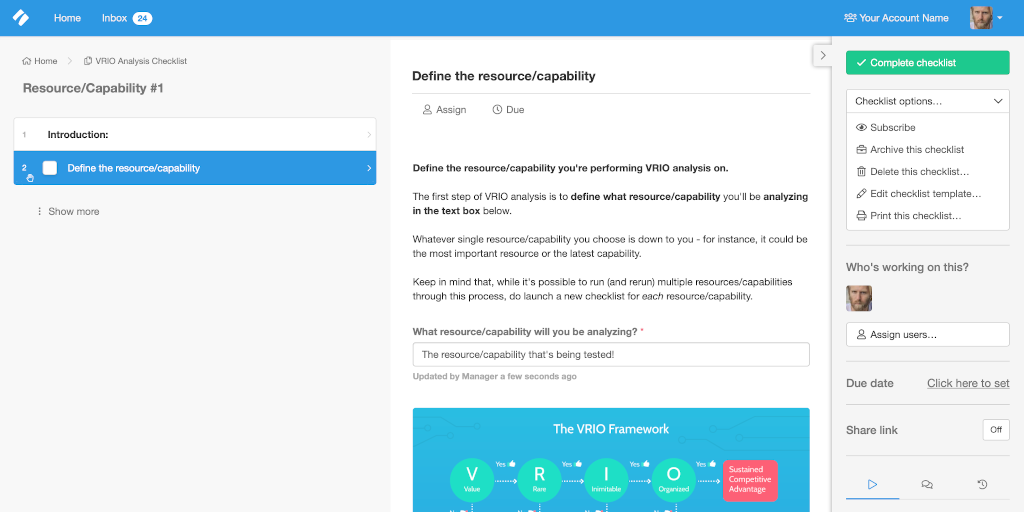
It’s then time to get to the nitty-gritty: Going through analysis with the first dimension – value!
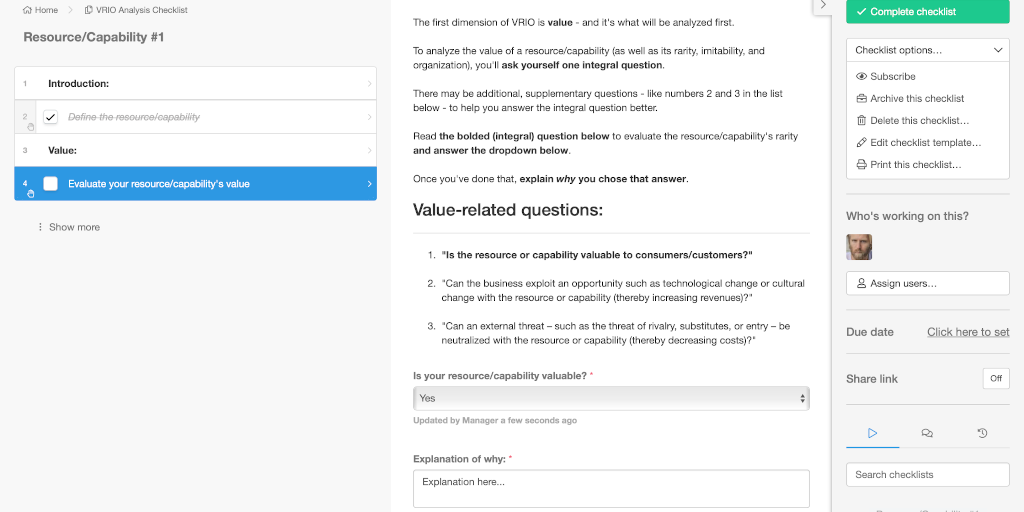
After asking yourself the necessary questions, the resource/capability passes with flying colors. The checklist then automatically directs you to the next dimension – rarity – and the appropriate task.
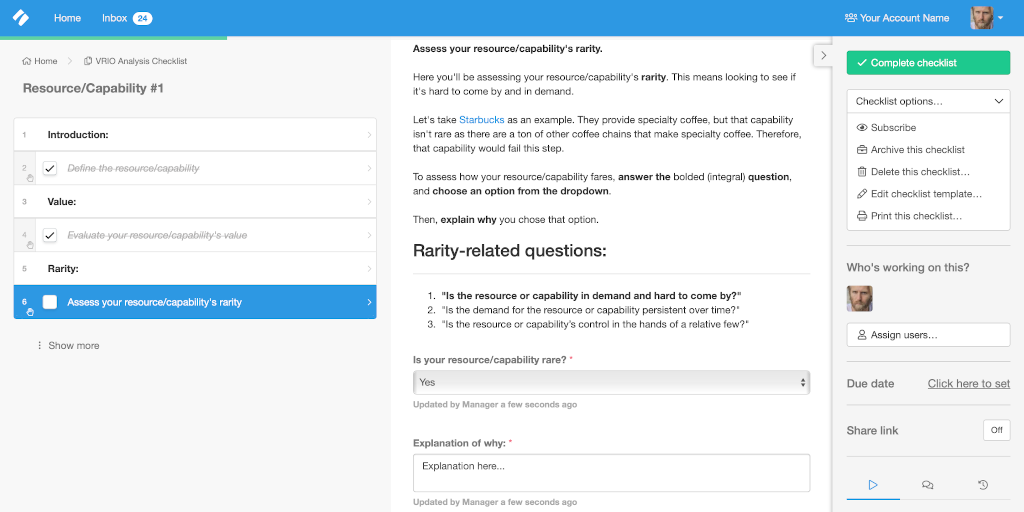
Once the integral question has been answered for rarity, the resource/capability passes that dimension, too.
The resource/capability then moves to the imitability dimension.
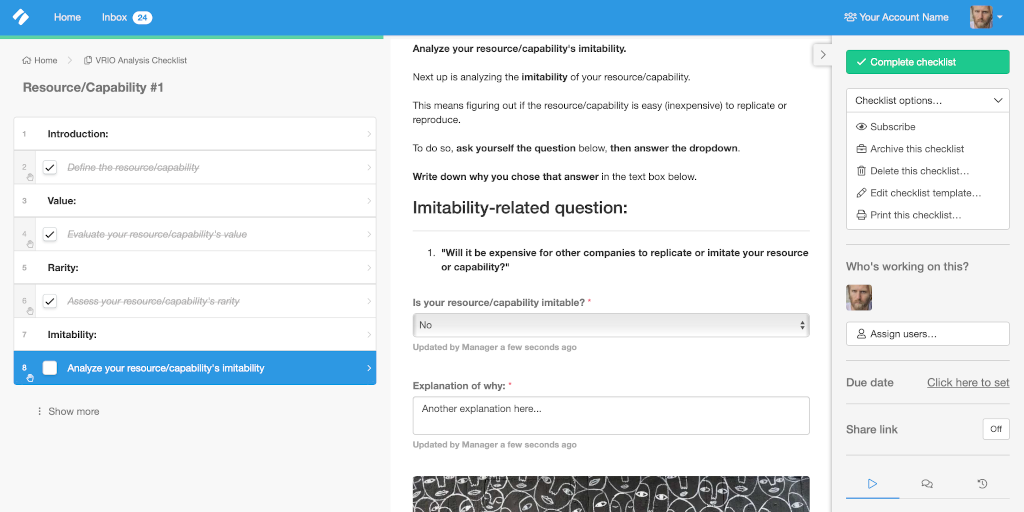
Then organization.
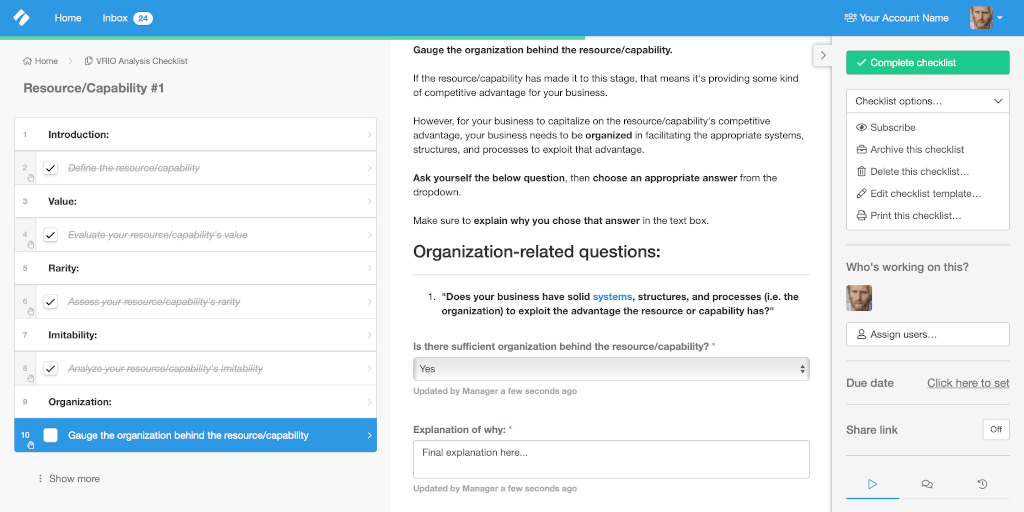
Like the other dimensions, organization is passed successfully, thus determining that the resource in question helps to bring a sustained competitive advantage.
Success! (That calls for more champagne and confetti poppers! )
However, for the next resource you test, it doesn’t get past the value dimension. The checklist then automatically hides all the other tasks, and shows you one you didn’t see before – “Learn what competitive disadvantage is”.
This task clearly describes what competitive disadvantage is, why the resource/capability didn’t progress through the framework, and what to do next.
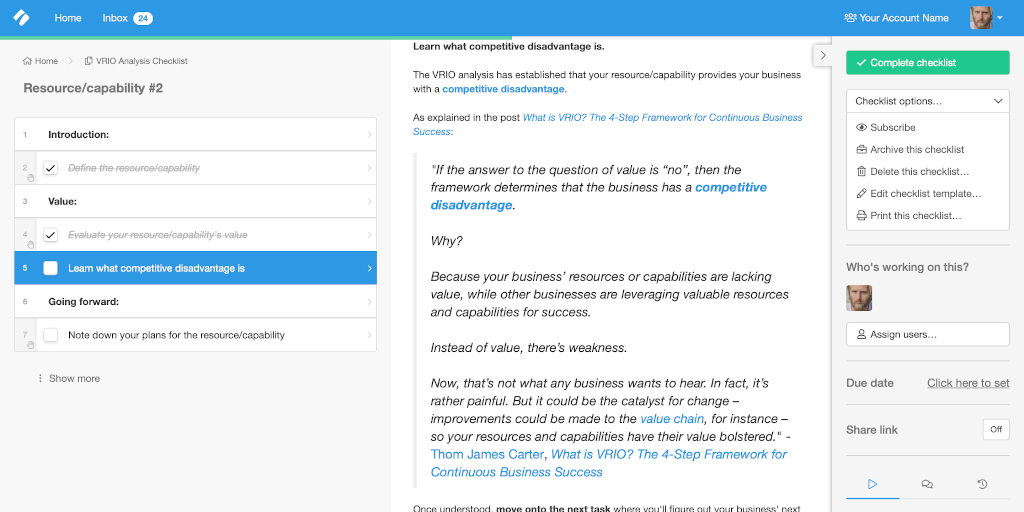
No matter the outcome – whether the resource/capability didn’t make it past the first hurdle or if it nailed all four dimensions – the checklist will always end in the same way: Asking you to note down your plans for the resource/capability. This is so you can figure out the next steps for the resource/capability.
Options could include altering things such as the value chain so it can rise further through VRIO’s dimensions, or perhaps getting rid of the resource/capability completely. Similarly, the task can help you strategize so that a sustained competitive advantage remains exactly that – sustained.
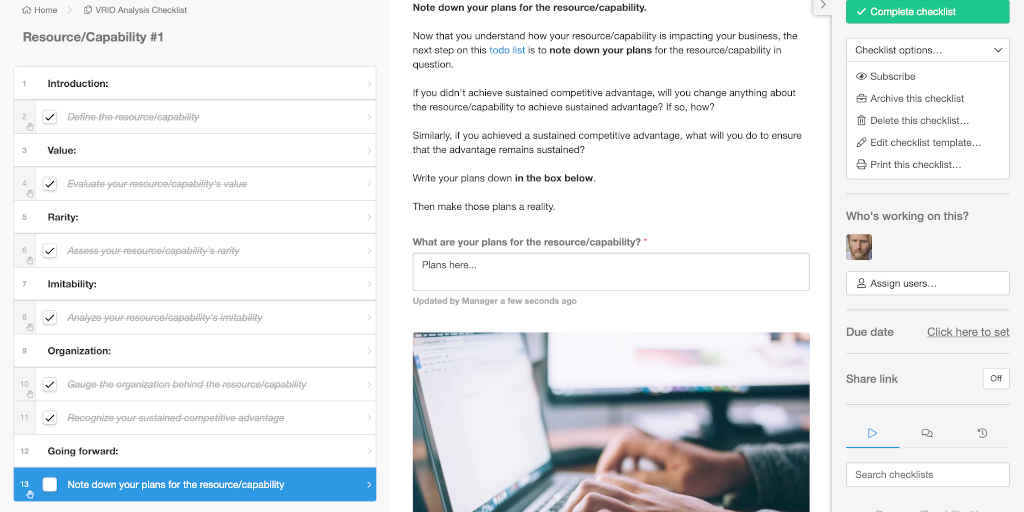
That’s how this checklist works – alongside conditional logic – in a nutshell!
But the workflow features added to this checklist don’t end there.
Stop tasks have also been incorporated, helping you to undergo VRIO analysis like a pro by making sure important tasks are never skipped over. (Tip: You can see if a stop task has been added to a task by the hand icon on the left-hand task list.)
Want to supercharge this checklist even further?
Task permissions can be utilized if you didn’t want certain members of your organization to see the data or results of the analysis.
Also, let’s say you’ve tasked another employee with undergoing VRIO analysis; you can use task or role assignments to assign them, then you can add dynamic due dates, so that the employee knows the tasks in the process must be completed by a certain time and date.
Learn more about some of these incredible features in the webinar below.
Tips for undergoing VRIO analysis with our checklist
VRIO analysis + Process Street’s BPM software = a match made in heaven.
That being said, there are certain tips to read, understand, and put into practice, so you can get as much value out of both VRIO and Process Street as you possibly can.
I know you’re raring to undergo VRIO like the G.O.A.T., so I won’t beat around the idiomatic bush.
Here are the tips in question:
-
- Only analyze one resource/capability at a time. ☝️
The checklist has been tailor-built to analyze only one resource/capability at a time. So, if you’ve got 2, 20, or even 200 resources and capabilities to go through, launch an individual checklist for each resource/capability. This won’t be an issue, though, as you can launch an infinite number of checklists with Process Street!
-
- Give each checklist the name of the resource/capability you’re analyzing. ✏️
If you want to look at the results or notes you wrote at the end of each archived checklist at a later date, giving the checklist an appropriate name will make diving back in much easier.
-
- Compile your data and results.
So you can see how they compare to each other, create a compiled document where you list all your resources and capabilities and the VRIO analysis result that was attributed to each one. It’ll be particularly convenient for getting a complete view of all your resources and capabilities at once. The document itself could come in the form of an Excel spreadsheet, or something more visual, like a table.
-
- Make use of Zapier.
To make the above step even easier, you can use Zapier and Process Street integrations to automate the pushing of data from Process Street into apps like Excel, Word, or wherever else you want to host the data and results from VRIO analysis!
That’s the end of our list of tips for undergoing VRIO analysis with our checklist. There’s no need to commiserate yet, as we’ve got even more beneficial, practical content for you in the section below. ⬇️
Additional resources for a sustained competitive advantage
Having a sustained competitive advantage is no easy task.
That’s why, to help you on your journey, nearly every day of the working week we provide our community with tips, tricks, and insights to help your business achieve a sustained competitive advantage.
We place a big (read: humongous) emphasis on tools, systems, frameworks, and processes that help you analyze both your business’s positives and pain-points.
Now, when I said “all your birthdays have come at once” earlier on, I meant it.
Why?
Because you’re about to find a list of analysis-related blog posts and template resources to help you get ahead – and remain ahead – of the curve! From gap analysis to SWOT analysis, keyword analysis to FMEA, these stellar bits of content truly have you and your business covered.
First up, templates.
SWOT analysis template
SWOT stands for strengths, weaknesses, opportunities, and threats. Essentially, it’s an approach that uncovers strengths, weaknesses, opportunities, and threats in both a qualitative and quantitative way.
A SWOT analysis can be completed efficiently and effectively with our ready-made, ready-to-go template.
Click here to get the SWOT analysis template.
FMEA template: Failure mode and effects analysis
FMEA is another acronym. This time, however, it stands for failure mode and effects analysis.
Now, failure modes and effects analysis are two different things.
Failure modes can be boiled down to the ways problems could occur.
Effects analysis, meanwhile, is the high-value process of looking at those failure modes and then identifying their impact.
To put it simply, FMEA is a brilliant system for spotting potential problems and failures before they occur, and then making sure they don’t happen!
Click here to get the template for FMEA: Failure mode and effects analysis.
Sales competitive analysis checklist
Just as VRIO can be used to analyze competitors, you can also use this sales competitive analysis checklist for the same purpose.
The advantage of this checklist, though, is that it deep dives into one particular aspect: Sales.
To explain this checklist’s incredible usefulness, read this quote from Alex Gallia, my colleague at Process Street:
“This checklist is designed to guide you through a comprehensive competitor analysis to help you identify your advantages with regards to content, product features, and pricing, finishing with an opportunity to incorporate your findings into pitch decks.” – Alex Gallia, 8 Account Management Checklists for Long-Term Customer Success
Click here to get the sales competitive analysis checklist.
Performance marketing (PPC) keyword competition analysis checklist
Businesses can’t just know themselves they’re better than their competition – potential customers and consumers need to know it, too.
Appearing on the front page of a Google search is one way for a business to cement their expertise.
However, companies competing in the same field or industry are all vying for a front-page ranking, whether through organic or paid means. That’s why, before launching any keyword-focused paid ads, you’ll want to analyze the competition to see if there are opportunities for the taking.
Our PPC keyword competition analysis checklist makes the whole process simple. (Not to mention fast.)
Click here to get the performance marketing (PPC) keyword competition analysis checklist.
SMART goal setting checklist
After aspects of your business have been analyzed, you’ll naturally have a list of related goals you’ll want to achieve.
Achieve them by using our SMART goal setting checklist.
It’s built to help you set goals, and then attain them in a sustainable, practical way.
Not only is this checklist helpful for business-related goals, but it can also be used on a personal front, too!
Click here to get the SMART goal setting checklist.
That covers our analysis-related templates that’ll help your business leaps and bounds.
Next up is a list of blog posts to sink your teeth into!
Blog posts for achieving a sustained competitive advantage
- Business Process Analysis (Without the Jaw-Breaking Yawn)
- Workflow Analysis: Apple’s Secret Ingredient to Success
- Gap Analysis: How to Bridge the Gap Between Performance and Potential
- SWOT Analysis Template: What, How, & Why? (Free Template)
- Business Process Optimization: What, How, Why? (Free Templates)
- How You Can Create a Sustainable Business For Long-Term Success
- Economic Sustainability For Success: What It Is And How To Implement It
- 8 Account Management Checklists for Long-Term Customer Success
- A Practical Guide to Increase Productivity with Process Mapping
There you have it.
You’ve been given a ton of information on VRIO, a free VRIO analysis checklist, tips on how to use it, plus additional templates and blog posts to help your business be the best it can be!
I can’t wait to see how it’ll all positively improve your business.
Have you undergone VRIO analysis or another kind of business analysis before? If so, how did you find the process? And is it something you do on a repeated basis? Let me know in the comment section below!







 Workflows
Workflows Forms
Forms Data Sets
Data Sets Pages
Pages Process AI
Process AI Automations
Automations Analytics
Analytics Apps
Apps Integrations
Integrations
 Property management
Property management
 Customer management
Customer management
 Human resources
Human resources
 Information technology
Information technology








Thom James Carter
Thom is one of Process Street’s content writers. He’s also contributed tech-related writing to The New Statesman, Insider, Atlassian, G2, The Content Marketing Institute, and more. Follow him on Twitter @thomjamescarter.